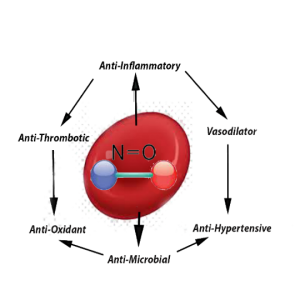Nitric Oxide as a Deterrent in the Fight Against COVID-19
What is Nitric Oxide?

Figure 1. Various positive effects of NO, showing that they are all interconnected.
What comes to mind when you think about nitrates and nitrites? Perhaps meat preservatives. However, throughout the last dozens of years, the importance of these two molecules have become profound through their connection with nitric oxide (NO). Nitrates and nitrites are converted into NO through the nirate-nitrite-NO pathway that starts from the mouth and ends in the red blood cells. Nitric oxide is a Nobel prize award winning molecule that serves mainly as a vasodilator but has properties of being anti-microbial and anti-inflammatory. It has key roles in pulmonary vascular function, as well as platelet adhesion, and thrombosis.
What is its connection with COVID-19?
Through recent months, it has become clear by the CDC that the infamous SARS-CoV-2, the coronavirus that causes COVID-19, implicates those with underlying conditions far more than those without. Some of these conditions can be but are not limited to diabetes, cancer, and sickle cell disease. Naturally, these conditions are deadly enough by themselves, but with the addition of the highly infectious COVID-19, it is extremely deadly. The absence of specific treatments and the high mortality rate, going as high as 160,000 confirmed deaths in the US alone, makes this virus a force to be reckoned with. However, the FDA recently granted inhaled nitric oxide (iNO) emergency expanded access for the treatment of patients with COVID-19. The method by which it can aid in this front is through its key role in vasodilating, thus providing more oxygen to places that need it in the body. It has become clear that nitric oxide is pivotal in the fight against the virus.
SARS-CoV-1 to SARS-Cov-2
During the outbreak of the SARS-CoV-1 infection which led to SARS (Severe Acute Respiratory Syndrome) in 2003, nitric oxide interfered with its replication cycle through one of the organic NO donors, S-nitroso-N-acetylpenicillamine. Given that as a precedent, nitric oxide as a treatment option for patients with severe pulmonary problems and coronavirus is viable. A 34-year-old woman who was diagnosed with pulmonary hypertension and COVID-19 has recently started inhaled nitric oxide therapy for supplemental oxygen. Although this treatment method has been used on a limited number of patients, a phase 3 study that has been approved by the FDA for the use of iNO is currently underway.
This blog post was submitted by Fernando Rigal as part of our Summer 2020 blog contest. You can vote for your favorite on our Twitter, Facebook and LinkedIn. The winner will be announced on September 14, 2020.
References
Sim, Ji-Yeon. “Nitric oxide and pulmonary hypertension.” Korean journal of anesthesiology vol. 58,1 (2010): 4-14. doi:10.4097/kjae.2010.58.1.4
Wajih, Nadeem et al. “Erythrocytic bioactivation of nitrite and its potentiation by far-red light.” Redox biology vol. 20 (2019): 442-450. doi:10.1016/j.redox.2018.11.001
GW School of Medicine & Health Sciences. “Nitric Oxide May Slow Progression of COVID-19.” GW School of Medicine & Health Sciences, 21 July 2020, smhs.gwu.edu/news/nitric-oxide-may-slow-progression-covid-19.
Sara Åkerström, Mehrdad Mousavi-Jazi, Jonas Klingström, Mikael Leijon, Åke Lundkvist, Ali Mirazimi Journal of Virology Jan 2005, 79 (3) 1966-1969; doi: 10.1128/JVI.79.3.1966-1969.2005
Scott, Keith. “Evidence Mounts Supporting Inhaled Nitric Oxide as COVID-19 Treatment.” Healio News, 20 May 2020, www.healio.com/news/primary-care/20200520/evidence-mounts-supporting-inhaled-nitric-oxide-as-covid19-treatment.


